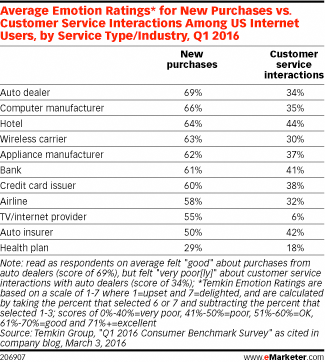How Are Brands Meeting, and Exceeding, Customer Expectations?
May 19, 2016
![]() The increasingly connected world we live in continues to drastically alter the relationship between brands and their customers. Arguably this change is most obvious in the growing expectation for always-on, real-time interactions across any device. More often, newer, disruptive entrants—not incumbent brands—are setting these new standards for customer expectations.
The increasingly connected world we live in continues to drastically alter the relationship between brands and their customers. Arguably this change is most obvious in the growing expectation for always-on, real-time interactions across any device. More often, newer, disruptive entrants—not incumbent brands—are setting these new standards for customer expectations.
 As explored in a new eMarketer report, “The Customer Experience Mandate: Brand Strategies to Meet and Exceed Customers’ Always-On Expectations,” the number of potential channels or touchpoints in which one can encounter a brand is vast and continuing to expand—and they’re not always direct or controlled. Customers don’t view these interactions as channel-centric or as journeys, paths and lifecycles in the same way a brand might view them. Each one, however small, elicits emotion from the person at the other end. Over time, these individual interactions or moments accrue, forming the basis for customer experience.
As explored in a new eMarketer report, “The Customer Experience Mandate: Brand Strategies to Meet and Exceed Customers’ Always-On Expectations,” the number of potential channels or touchpoints in which one can encounter a brand is vast and continuing to expand—and they’re not always direct or controlled. Customers don’t view these interactions as channel-centric or as journeys, paths and lifecycles in the same way a brand might view them. Each one, however small, elicits emotion from the person at the other end. Over time, these individual interactions or moments accrue, forming the basis for customer experience.
 August 2015 research from Nice Systems and Boston Consulting Group (BCG) found that internet users in major metro areas worldwide used an average of 5.6 customer service channels. One-third of respondents reported that they used seven or more service channels, and only 3% said they used one. For most businesses, these channels are rarely just digital. Brick-and-mortar stores, call centers or even direct mail could all encompass their particular world of touchpoints.
August 2015 research from Nice Systems and Boston Consulting Group (BCG) found that internet users in major metro areas worldwide used an average of 5.6 customer service channels. One-third of respondents reported that they used seven or more service channels, and only 3% said they used one. For most businesses, these channels are rarely just digital. Brick-and-mortar stores, call centers or even direct mail could all encompass their particular world of touchpoints.
John Caruso, partner and creative director at digital experience agency MCD Partners, believes that this always-on environment of multiple channels puts incredible pressure on brands to keep up. People “expect first-contact resolution for all their problems,” he said. “You pick up your device and you expect it to get resolved right away. Across all devices and platforms and services, customers expect it to all just work.”
Customers’ changing behaviors and heightened expectations are showing up on the radar of senior executives worldwide, based on September 2015 polling from consultancy Economist Intelligence Unit (EIU). The trend was listed third among respondents, behind increased globalization and industry regulation, as the potential to be the most disruptive to their core business in the coming year. It was deemed to be as big a threat as sector convergence and competition.
Marketers in particular recognize that customer priorities are shifting, based on February 2016 research from Duke University’s Fuqua School of Business. For example, US marketing executives viewed customer priorities like quality, service, trust and low price on relatively equal footing in August 2013. But over the course of the next two years and beyond, there was a marked shift in the importance of quality and service. In the eyes of marketers, these two priorities top all others among customers.
Courtesy of eMarketer





























